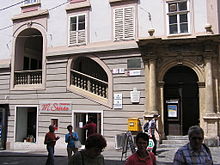Staircase church
The Stiegenkirche is a Roman Catholic church in the first district of Graz, Innere Stadt . It can be entered through a characteristic staircase from Sporgasse , as it stands behind the row of houses. It forms the " Rectorate at the Stiegenkirche in Graz " of the Graz Cathedral Parish in the Deanery Graz-Mitte of the City Church Graz .

history
The Stiegenkirche is the oldest parish church in Graz. It is located in the oldest part of Graz, where the " Paulsburg " was once located, and was first mentioned in a document in 1343 in an indulgence ceremony .
The name of the church appears as early as 1468 as " sand Paulsstiegen" . In the middle of the 16th century the staircase church seems to have hardly been used and in 1554 no more services were celebrated in it. In 1588 Archduke Karl II handed over the staircase church and a house to his chaplain and court music director Aurelius Mancinus von Pergola to accommodate the convent of the Augustinian hermits .
From 1619 the Augustinian hermits built the new church and monastery above the old Pauluskirche, which was largely completed by 1627. A year 1631 on the inside of the church door could indicate the completion of construction work. The new construction of the stairs by Antonio Solar is likely to have taken place around 1636. The end of the Augustinian hermit monastery brought about the abolition of the monastery by Emperor Joseph II in 1784 .
From 1886 to 1957 the staircase church was the church of the Jesuits. During the Second World War, the church was damaged by a bomb strike in 1945 and was rebuilt from 1950 to 1953 according to plans by the architect Franz Klammer. A church rectorate has been set up since 1957.
In 1962 the church was renovated according to plans by the architect Kurt Weber-Mzell . On the occasion of the Austrian Catholic Day , the interior was redesigned by the diocesan liturgy commission and the working group of the architects Edda Gellner, Fritz Neuhold and Karl Raimund Lorenz. A sandstone Madonna in the church courtyard was made by the West Styrian sculptor Alfred Schlosser .
literature
- Alois Kölbl, Wiltraud Resch: Paths to God. The churches and synagogue of Graz. 2nd, expanded and supplemented edition. Styria, Graz 2004, ISBN 3-222-13105-8 , p. 107f.
Web links
Individual evidence
- ^ A b Walter Brunner on behalf of the City of Graz, Kulturamt (ed.): History of the City of Graz (in 4 volumes), self-published by the City of Graz 2003, ISBN 3-902234-02-4
- ↑ Gertrude Vanek: The West Styrian sculptor Alfred Schlosser. Notes on the iconography of a popular visual world of the present. Diploma thesis at the Institute for Folklore of the Karl-Franzens-University Graz 1998, p. 224.
Coordinates: 47 ° 4 ′ 21.3 " N , 15 ° 26 ′ 19.6" E




